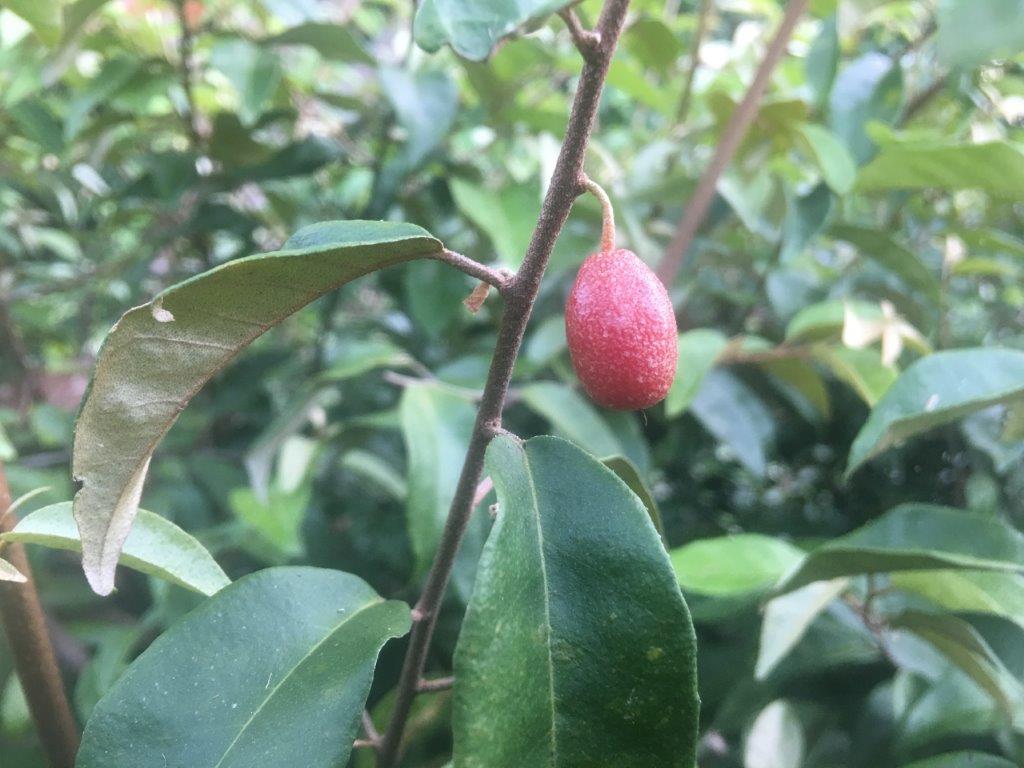A gold dusted Aussie fruit that will bring in the birds
By Bruce Thompson –
Common Name: Millaa Millaa, Millaa Millaa Vine
Genus: Elaeagnus
Species: triflora
Family: Elaeagnaceae
Origin: Occurs in tropical rainforests and swamp forests in Queensland from Cape York south to Rockhampton. It also occurs as secondary scrub with Gleichenia species as well as thickets and scrubs from the lowland up to 1800m. It grows in great numbers as vines in trees around the town of Millaa Millaa, after which it is named. It can be found in both full sun and part shade, with fruiting more prevalent at locations which receive morning sun only. Millaa Millaa Vine is also found in Malesia.
Characteristics: Leaves are singular and alternate withpeltate scales which cover the underside of the leaves, giving them a metallic sheen that varies from silver to coppery gold. The upper leaf is leathery and dull to bright green. The full sun or filtered light growing location determines leaf colouring. Flowers are four-petalled, stellate and 4-9mm long. They are perfumed and also covered in peltate scales with a glabrous tube. The red, astringent tasting fruit is covered with bronze to gold coloured peltate scales giving them a luxurious ‘gold dust’ appearance. Fruits are singular and contain just the one seed which is star shaped when sectioned. Fruit ripens between November and March. The bark is sandpapery. Millaa Millaa is a vigorous climber especially in the tropics. One of the translations of “Millaa Millaa” in Mamu language is “a very wet place”, which suggests this plant needs lots of water which isn’t the case. Once established, Millaa Millaa is drought tolerant but regular watering during fruiting is advised for a good harvest. It needs to be planted in soils with good drainage, with mounding and annual gypsum applications advised when planted in heavy clay.
Uses: In the kitchen, Millaa Millaa makes a good contrasting addition to sweet dishes including fruit salads. It can be used to make jams and alcoholic beverages. They make a rich, highly coloured and interesting tasting red jelly. When cooked, the seed tastes like a peanut. First Nations people used the fruit to treat dysentery. Ecologically, Millaa Millaa’s flowers attract many species of beneficial insects and its fruit, and dense habit are important small bird habitat for species such as Olive-backed Sunbirds. Millaa Millaa is a plant species that has a symbiotic relationship with nitrogen fixing soil bacteria, with the nitrogen used by the growing plant as well as plants growing nearby. As a companion plant in orchards, Millaa Millaa has been shown to increase fruit yields by up to 10%. In landscaping, it can be trained up trellises, along fences or in large balcony pots so its flowers can provide fragrance with easy fruit picking access, and can also be shaped into dense hedges. Medicinally, Millaa Millaa contains ten times the amount of the antioxidant lycopene than that of tomatoes, and at least four times the lycopene of any other studied fruit growing on earth. This provides scope for pharmaceutical clinical research especially for the prevention and treatment of cancer.
Propagation: By seed and cutting with seed being the easiest method

